The back of the garden is a bit crazy right now, what with the miscanthus, the flowering tobacco, Eryngium pandanifolium, Roldana petasites, kangaroo paws and others jostling to claim their allotment of soil and sun. And if that wasn’t enough, just to keep things really interesting, I threw a big restio Rhodocoma capensis into the mix. But if my garden isn’t occasionally making me a little nervous, well, that just means I’m losing my nerve. But let’s have a look first at what’s happening that causes me no worry at all, just pure delight. Like this bloom on Meconopsis cambrica today.
Ha! Made you Google! The Welsh poppy is actually one of the easier meconopsis to grow, but I’m fairly certain it would prefer to spontaneously combust before deigning to grow in my dry zone 10 garden. No, this short-lived perennial poppy relative from Mexico is Hunnemania fumarifolia, from seed given to me from the blogger Piece of Eden. It is a stalwart compatriot for my dryish garden and insinuates itself among the gaggle of plants I’m growing with true team spirit.
A new Cactus Geranium, so good in pot culture whatever your zone, this little Pelargonium echinatum ‘Julie Scheller’ was part of a recent order from Geraniaceae. The color is mutable, changeable from white to pink, which is also a trait of one of the plants I’m going to talk about in the back of the garden, Nicotiana mutabilis. The nicotiana also started out in a pot, but unlike the Cactus Geranium, the nicotiana would require arduous effort to keep watered in a pot for months on end. (Deborah Silver accomplishes pot culture for the nicotiana beautifully in the shorter growing season of Detroit, so it is doable in less dry climates.)
Under that table a spring tide of Salvia ‘Big Pink’ pools. I watched a hummingbird duck and dive under the pergola yesterday for a quick nip. Did I plan for so much pink? Not at all. For a small, dry zone 10 garden, color planning, even if I were so inclined (and I’m not) is out the window — because odds are there won’t be a lot of flowers in bloom at any one time, for any length of time, to cause much of a controversy in any case. If the plant will thrive in the same conditions as my aloes and agaves, I’m effectively color-blind. And for me it’s not so much about color anyway, as performance, movement, bearing.
In the back of the garden is where I keep open ground to try out new plants, and treatment here is much richer than for the succulents closer to the house. Nicotiana mutabilis from Brazil bloomed lightly in a pot its first year, but since it also grows as a short-lived perennial in zone 10, after planting it in the ground for its second spring it has transformed into a huge, multi-stemmed, cabbagey-leaved bruiser — a bruiser that dangles delicate bells for me to examine head-height and for hummingbirds to plunder for nectar. It’s a muscular yet delicate performance that would win the admiration of Twyla Tharp.
At 5X4′ and with many side shoots still developing, I’m just not sure that this performance is sustainable for much longer as the weather heats up. Which is why I’m taking its portrait now. If as I expect, the heat produces epic wilt, I’ll cut it to the base and see what happens when the weather cools in fall.
Nicotiana mutabilis — delighted to finally meet you! I’ve heard so much about you! Make yourself comfortable. Feel free to put your feet up, throw some seed around…

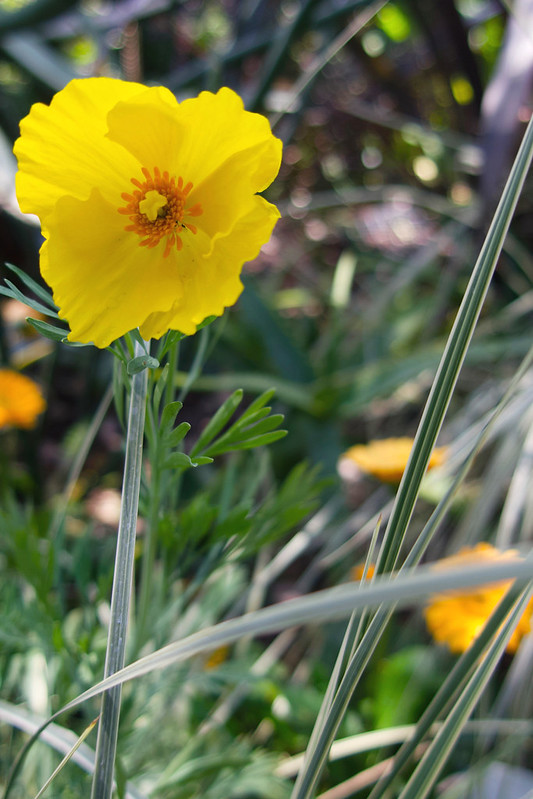
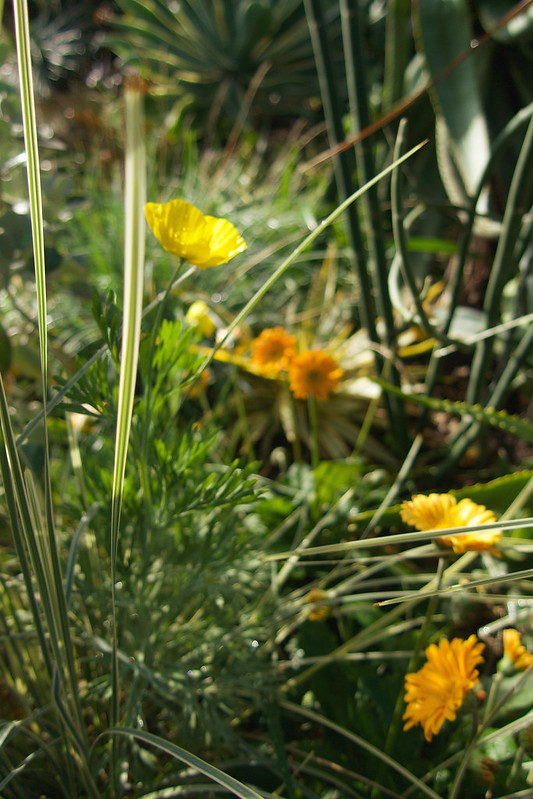

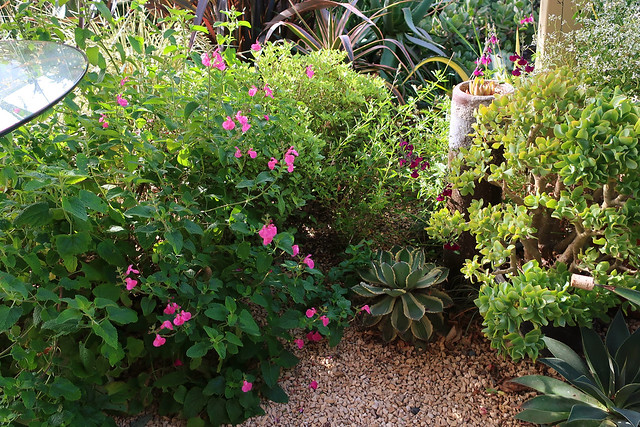
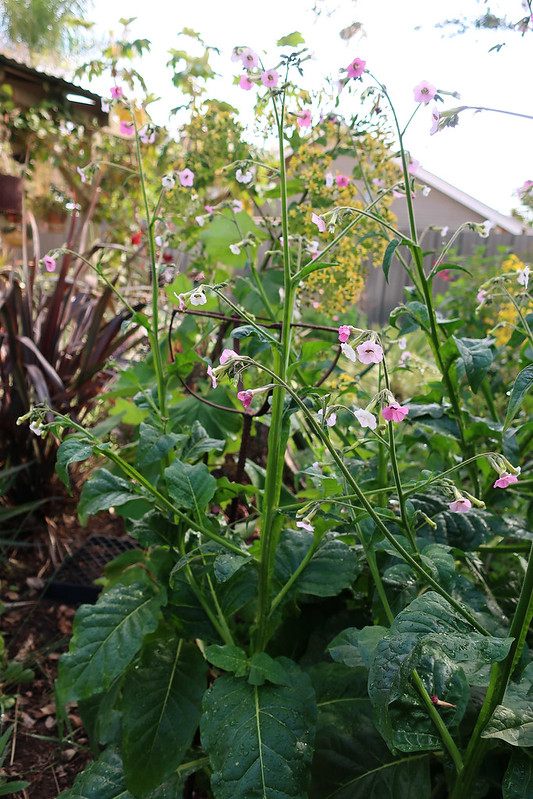


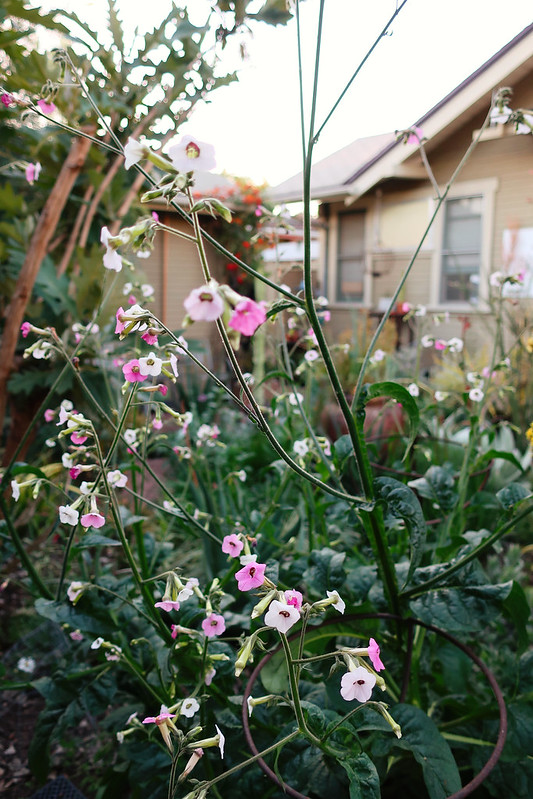
You always do well with poppies of all kinds. I’ve never been able to keep Hunnemannia alive for long and I’ve also repeatedly failed with Nicotiana. It’s too early for the warm temperatures we’re already getting, especially as rain was low, so I’m expecting both early departures and some no-shows among the early spring crowd as well.
My sister in Alaska reports Meconopsis of all sorts are effortless there. Major reason to tolerate a three-month (May 15 – Aug 15) gardening season?
Looks like you have considerable more sun now with the departure of the…Cypress (photo 5 and 7)? New conditions to play with. You are “Fearless” indeed.
Wow that nic is a bruiser but oh, so gorgeous. I love the photo showing the salvia under the table and the agave surrounded by giants. Its’ a great demo of size. I am trying a new nicotiana this year called Starlight Fantasy. Supposed to get tall and be incredibly fragrant. Fingers crossed.
Well that is lovely and even something I can grow in cold old England. It’s even been known to survive a winter here apparently. On my list for the next seed order. Thanks for the tip!
@Kris, yes, poppies and I go way back! You have such a riches of flowers that I think their absence is hardly noticed!
@Hoov, true, more sun pours in now. Not sure about fearless, more like reckless…
@Elaine, the nicotiana gets better and better. A couple of days in the high 80s didn’t phase it, but the ground is still fairly moist. Good luck with Starlight Fantasy!
@Jessica, I think it would settle in happily for you. Fortunately for me it was an easy start with small plants rather than seeds.